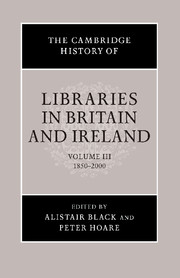Book contents
- Frontmatter
- Introduction: sources and methodologies for the history of libraries in the modern era
- 1 Libraries and the modern world
- Part One Enlightening the Masses: the Public Library as Concept and Reality
- 2 Introduction: the public library in concept and reality
- 3 The people's university: models of public library history
- 4 Libraries for leisure time
- 5 High seriousness: the reference and information role of the public library 1850–2000
- 6 Extending the public library 1850–1930
- 7 Public library outreach and extension 1930–2000
- 8 Public library services for children
- 9 Public library people 1850–1919
- Part Two The Voluntary Ethic: Libraries of our Own
- Part Three Libraries for National Needs: Library Provision in the Public Sphere in the Countries of the British Isles
- Part Four The Nation's Treasury: Britain's National Library as Concept and Reality
- Part Five The Spirit of Enquiry: Higher Education and Libraries
- Part Six The Rise of Professional Society: Libraries for Specialist Areas
- Part Seven The Trade and its Tools: Librarians and Libraries in Action
- Part Eight Automation Pasts, Electronic Futures: the Digital Revolution
- Bibliography
- Index
2 - Introduction: the public library in concept and reality
from Part One - Enlightening the Masses: the Public Library as Concept and Reality
Published online by Cambridge University Press: 28 March 2008
- Frontmatter
- Introduction: sources and methodologies for the history of libraries in the modern era
- 1 Libraries and the modern world
- Part One Enlightening the Masses: the Public Library as Concept and Reality
- 2 Introduction: the public library in concept and reality
- 3 The people's university: models of public library history
- 4 Libraries for leisure time
- 5 High seriousness: the reference and information role of the public library 1850–2000
- 6 Extending the public library 1850–1930
- 7 Public library outreach and extension 1930–2000
- 8 Public library services for children
- 9 Public library people 1850–1919
- Part Two The Voluntary Ethic: Libraries of our Own
- Part Three Libraries for National Needs: Library Provision in the Public Sphere in the Countries of the British Isles
- Part Four The Nation's Treasury: Britain's National Library as Concept and Reality
- Part Five The Spirit of Enquiry: Higher Education and Libraries
- Part Six The Rise of Professional Society: Libraries for Specialist Areas
- Part Seven The Trade and its Tools: Librarians and Libraries in Action
- Part Eight Automation Pasts, Electronic Futures: the Digital Revolution
- Bibliography
- Index
Summary
The appearance and growth of ‘free’ local libraries funded from local taxation, which for over a century we have referred to as public libraries, resulted from the Public Libraries Act (1850), which initially applied to England and Wales. The Act was extended to Scotland and Ireland in 1853. Contributors to this section deal largely with the history of the public library in England. Developments in Wales, Scotland and Ireland receive specific attention in a later section in the volume. However, it should be stressed that many of the motives, drivers and issues of past public library development in England were to be found, to a greater or lesser extent, elsewhere in the British Isles.
Before public libraries were formally inaugurated in 1850, there had developed a patchwork of libraries of various kinds – for example, endowed libraries, ecclesiastical libraries, subscription libraries, book clubs and collections in coffee houses – that could in some ways be described as ‘public’. But these libraries normally involved some kind of payment, either directly for use of the library, or indirectly for the service, as in the case of coffee houses, to which the library was appended. Proposals for libraries free at the point of use and subsidised from the public purse appeared a number of times in the first half of the nineteenth century. The idea was raised by the Society for the Diffusion of Useful Knowledge (SDUK) in 1826 and by the Select Committee on Enquiry into Drunkenness (1834). The idea also formed part of an unsuccessful Public Institutions Bill (1835) and featured in the deliberations of the Select Committee on Arts and Their Connection with Manufactures (1835–6).
- Type
- Chapter
- Information
- Publisher: Cambridge University PressPrint publication year: 2006
- 2
- Cited by



